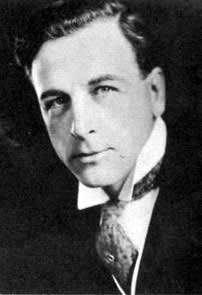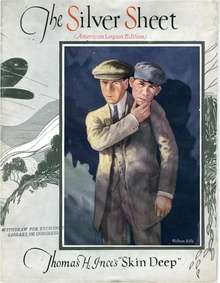Milton Sills
| Milton G. G. Sills | |
|---|---|
 Sills in a 1920 publicity photograph | |
| Born |
January 12, 1882 Chicago, Illinois, U.S. |
| Died |
September 15, 1930 (aged 48) Los Angeles, California, U.S. |
| Occupation | Actor |
| Years active |
1906–1914 (stage) 1914–1930 (film) |
| Spouse(s) |
Gladys Edith Wynne (m. 1910–25) (divorced) Doris Kenyon (m. 1926–30)(his death) |
Milton George Gustavus Sills (January 12, 1882 – September 15, 1930) was an American stage and film actor of the early twentieth century.
Biography
Sills was born in Chicago, Illinois into a wealthy family. He was the son of William Henry Sills, a successful mineral dealer, and Josephine Antoinette Troost Sills, an heiress from a prosperous banking family. Upon completing high school, Sills was offered a one-year scholarship to the University of Chicago, where he studied psychology and philosophy. After graduating, he was offered a position at the university as a researcher and within several years worked his way up to become a professor at the school.
In 1905, stage actor Donald Robertson visited the school to lecture on author and playwright Henrik Ibsen and suggested to Sills that he try his hand at acting. On a whim, Sills agreed and left his teaching career to embark on a stint in acting. Sills joined Robertson's stock theater company and began touring the country.
In 1908, while Sills was performing in New York City, he attracted the notice of Broadway producers such as David Belasco and Charles Frohman. That same year he made his Broadway debut in This Woman and This Man.[1] From 1908 to 1914, Sills appeared in about a dozen Broadway shows.
In 1910, Sills married English stage actress Gladys Edith Wynne, a niece of actress Edith Wynne Matthison. The union produced one child, Dorothy Sills; Gladys filed for divorce in 1925.[2] In 1926, Sills married silent film actress Doris Kenyon with whom he had a son, Kenyon Clarence Sills, born in 1927.
Motion pictures

In 1914, Sills made his film debut in the big-budget drama The Pit for the World Film Company and was signed to a contract with film producer William A. Brady. Sills made three more films for the company, including The Deep Purple opposite Clara Kimball Young.[1]
By the early 1920s, Sills had achieved matinee idol status[3] and was working for various film studios, including Metro Pictures, Famous Players-Lasky, and Pathé Exchange. In 1923 he was Colleen Moore's leading man in the very successful Flaming Youth,[4] but his biggest box office success was The Sea Hawk (1924), the top-grossing film of that year.[5] In 1926 he wrote the screenplay for Men of Steel, also starring in it along with Kenyon.[6]
Sills had begun to make the transition to sound pictures as early as 1928 with the part-talking The Barker. His final appearance was in the title role of The Sea Wolf (1930), a performance called "incisive" by the New York Times.[7]
Death and legacy
Sills died unexpectedly of a heart attack in 1930 while playing tennis with his wife at his Brentwood home in Los Angeles, California at the age of 48. He was interred at the Rosehill Cemetery and Mausoleum in Chicago, Illinois. In December 1930, Photoplay published a poem found among his personal effects.[8]
He was a founding member in 1913 of Actors' Equity.[9] On May 11, 1927, he was among the original 36 individuals in the film industry to found the Academy of Motion Picture Arts and Sciences (AMPAS), a professional honorary organization dedicated to the advancement of the arts and sciences of motion pictures.[10]
Sills also wrote a book, published posthumously in 1932: Values: A Philosophy of Human Needs – Six Dialogues on Subjects from Reality to Immortality, co-edited by Ernest Holmes.[11]
For his contribution to the motion picture industry, Milton Sills received a star on the Hollywood Walk of Fame at 6263 Hollywood Boulevard.[12] Sills was the favorite actor of poet Weldon Kees as a child, and Sills' Men of Steel influenced Kees' poem "1926".[13]
Selected filmography
- The Deep Purple (1915)
- Under Southern Skies (1915)
- Patria (1917)
- The Yellow Ticket (1918)
- The Struggle Everlasting (1918)
- The Yellow Ticket (1918)
- The Hell Cat (1918)
- Shadows (1919)
- Eyes of Youth (1919)
- The Fear Woman (1919)
- What Every Woman Learns (1919)
- Behold My Wife! (1920)
- Salvage (1921)
- At the End of the World (1921)
- The Great Moment (1921)
- Miss Lulu Bett (1921)
- A Trip to Paramountown (1922)(*short film)
- The Forgotten Law (1922)
- The Isle of Lost Ships (1923)
- The Spoilers (1923)
- Adam's Rib (1923)
- Flaming Youth (1923)
- The Sea Hawk (1924)
- Single Wives (1924)
- As Man Desires (1925)
- Madonna of the Streets (1925)
- The Knockout (1925)
- Paradise (1926)
- Men of Steel (1926)
- The Sea Tiger (1927)
- The Valley of the Giants (1927)
- Burning Daylight (1928)
- The Hawk's Nest (1928)
- The Barker (1928)
- Love and the Devil (1929)
- Man Trouble (1930)
- The Sea Wolf (1930)
References
- 1 2 Golden, Eve (2000). Golden Images: 41 Essays on Silent Film Stars. McFarland. p. 163. ISBN 978-0-7864-8354-9.
- ↑ "News from the Dailies – Los Angeles". Variety. October 7, 1925. p. 10 – via Internet Archive.
- ↑ Basinger, Jeanine (October 2012). Silent Stars. Knopf Doubleday. ISBN 978-0-307-82918-4.
- ↑ Ross, Sara (2000). "The Hollywood Flapper and the Culture of Media Consumption". In Desser, David; Jowett, Garth. Hollywood Goes Shopping. U of Minnesota Press. p. 73. ISBN 978-0-8166-3513-9.
- ↑ Dirks, Tim. "Box-Office Hits By Decade and Year". filmsite. Retrieved 2016-02-07.
- ↑ "Men of Steel". Catalog of Feature Films. American Film Institute.
- ↑ "Milton Sills's Last Film". The New York Times. October 6, 1930. Retrieved 2016-02-07.
- ↑ "Milton Sills' Goodbye". Photoplay. December 1930. p. 96 – via Internet Archive.
- ↑ Bloom, Ken (2013). Routledge Guide to Broadway. Taylor & Francis. p. 21. ISBN 978-1-135-87116-1.
- ↑ Pawlak, Debra Ann (2012). Bringing Up Oscar: The Story of the Men and Women Who Founded the Academy. Pegasus Books. p. 7. ISBN 978-1-60598-216-8.
- ↑ Soister, John T. (2012). American Silent Horror, Science Fiction and Fantasy Feature Films, 1913–1929. McFarland. p. 190. ISBN 978-0-7864-8790-5.
- ↑ "Milton Sills". Hollywood Walk of Fame. Hollywood Chamber of Commerce. Retrieved 2016-02-04.
- ↑ Reidel, James (2007). Vanished Act: The Life and Art of Weldon Kees. U of Nebraska Press. p. 20. ISBN 0-8032-5977-8.
External links
| Wikimedia Commons has media related to Milton Sills. |
- Milton Sills at the Internet Movie Database
- Milton Sills at the Internet Broadway Database
- Photographs and literature
- "The Actor's Part", article written by Sills in 1927